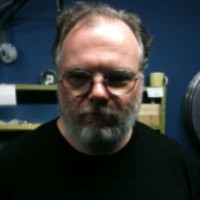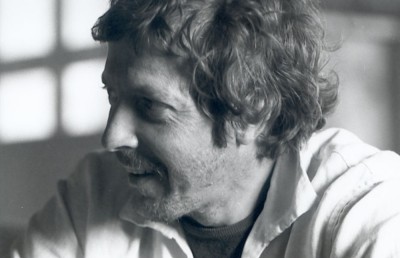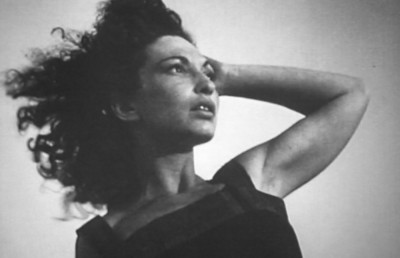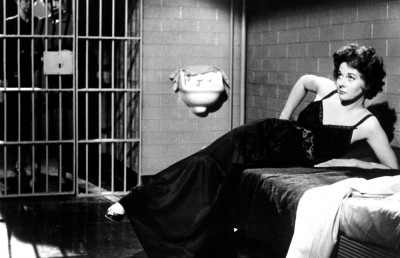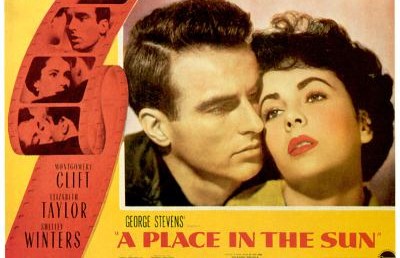Theatrical Elements in Mizoguchi’s Cinema
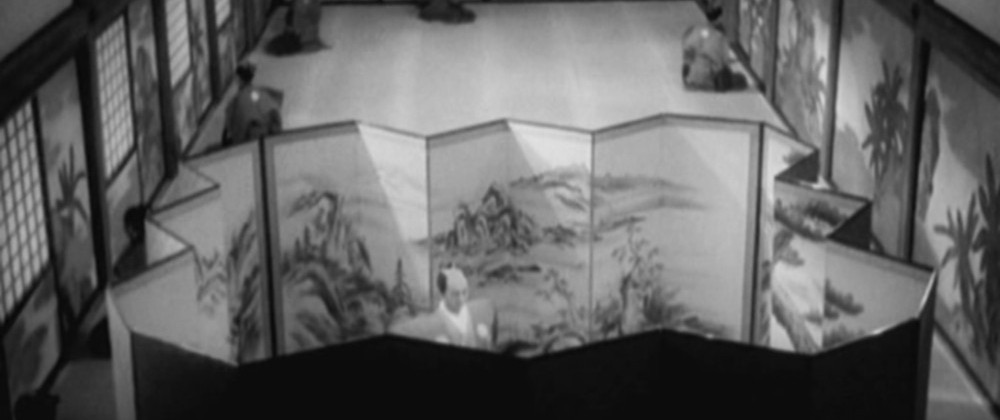
In Kenji Mizoguchi’s films Osaka Elegy (1936), The Story of the Last Chrysanthemum (1939), The 47 Ronin, Parts 1 and 2 (1941-1942) and Ugetsu (1953), there are repeated references to bunraku, kabuki and noh theatre, and examples of their styles being incorporated into his directorial strategies. His love of theatre is well documented, and all these films include extracts from theatrical performances which relate thematically to the films they appear in as well as informing their action. Even in non-theatrical settings, the influence of Japanese theatre can be found in Mizoguchi’s use of music, performance techniques, camera angles and movement, set design and placing of figures within the frame. Even the use of the long take can be thought of as at least partly theatrical in origin, since what is a stage play if not a story told in a series of long takes?
Several critics point to the formative effect of Mizoguchi’s love of theater. Keiko McDonald notes his acquiring a “passion for the stage” while a student [1], while Dudley Andrew describes him as a lifelong “addicted spectator.” [2] Given this, it is a short step to Tadao Sato’s argument that the one scene, one shot technique is connected to “the traditionally slow tempo to be found in Japanese dance, puppet drama, [or] the music of noh drama.” [3] Peter Morris partially disagrees, suggesting the main source of this method is Mizoguchi’s background as a painter [4], but does concede the influence of early silent films with their relatively long single-take scenes. [5] Mizoguchi himself acknowledges the influence of early cinema in his search for a technique that would “avoid the use of the close-up.” [6] But the source of these silent cinema traits can be traced back to stage performance, and most filmmakers had discarded them by the 1920s as “uncinematic.” [7]
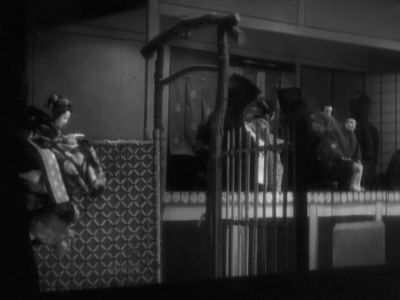
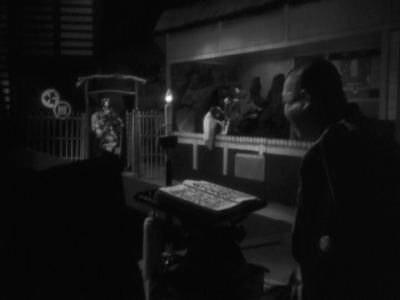
Osaka Elegy
The theatrical performance shown in Osaka Elegy is a bunraku play. In this type of drama, hooded and cloaked puppeteers in black manipulate life-size puppets in full view of the audience while, to the side and also visible, a musician plays the samisen (a Japanese stringed instrument) and a chanter recites all the parts in the various characters’ voices. The sequence begins with the performance seen in repeated long shots from selected audience perspectives intercut with shots of Ayako (Isuzu Yamada) and Asai (Benkei Shiganoya) watching from balcony seats. The action then continues in the hallway outside as they are confronted by Sumiko (Yoko Umemura), Asai’s wife. The play, in which a puppet resembling a bourgeois type insists on being given an increasingly painful treatment which climaxes with his head being burned, seems purely farcical. McDonald, however, identifies the play as Double Suicide at Amijima, a tragedy about a romance between a paper merchant and a courtesan, and suggests that ??Osaka Elegy??’s characters function as vulgar parodies of the tragic originals. [8] So while the scene in the hall is played straight, the play’s music and chanting, which continues as off-screen sound, exposes the squalid and farcical nature of the film’s characters’ interactions. Also of interest is the contrast between the editing of the play’s performance, a rhythmic alternation of shots averaging eight cuts per minute, and that of the hallway scene, which over roughly two minutes features five cuts, including a brief return to a view of the stage. While the play is shot “cinematically,” the film action reflects the more deliberate pace of bunraku theatre. Additional references to the play can be seen in the staging. When Sumiko arrives, she is accompanied by a maid who is dressed in black and stands behind her silently, like a puppeteer. When Asai tries to slink away, Sumiko calls him back and he returns as if pulled by a string. Most importantly, the doctor gives Fujino a “ridiculous role to play” by pushing him forward to claim Ayako is his girlfriend, while keeping out of sight behind a corner. That is, like a bunraku puppeteer, he is visible to the viewing audience, but not to the characters “onstage.” In a film about a protagonist who has little control over her fate until, perhaps, the very end, this puppet imagery has thematic resonance.
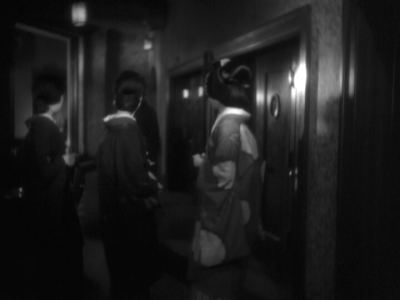
Backstage, Osaka Elegy
The Story of the Last Chrysanthemum contains three extended performance scenes. Like the play in Osaka Elegy, they are, as Noel Burch points out, “densely edited in accordance with a system completely different from that which otherwise prevails.” [9] A partial explanation is this is a film about the relationship of an actor with his audience, his fellow performers and his lover. So while the performances chart Kikunosuke (Shotaro Hanayagi)’s development as an actor and offer an exuberant celebration of kabuki, what is most important is not his acting, but the reactions to it. In Osaka Elegy, there are no shots that register individual reactions to the bunraku performance, but in Chrysanthemum??’s second performance sequence, 15 of the 32 shots are of either his anxious lover Otoku (Kakuko Mori) or one of the impressed fellow actors watching Kikunosuke from the wings. As in the earlier film, Mizoguchi matches the cinematic rendering of the play with less edited, more theatrical, non-stage action. Sato identifies a key aspect of kabuki dance performance as its “attachment to the beauty of a picture-like form, and [that] it is said to ‘fix upon’ a single moment.” [10] Another way of expressing this is that the “poses a kabuki attains are held until they hold (apply) no longer.” [11] This holding of a pose can be seen in the sequence where Otoku leaves the theatre following Kikunosuke’s triumph. The rectangular building and tree in front of it creates a stage-like space, while samisen and wood-block music is heard from the theatre behind her. She moves “stage front” and drops to her knees as drums beat, holding the pose expressively for several moments until joined by Kikunosuke. This is an example of how the kabuki acting space spills out of the theatre and into the film’s “real” action. A different kind of blurring of the border between the arena of theatrical performance and that of a film’s reality can be seen in ??Ugetsu. Lady Wakasa (Machiko Kyo) is made up to resemble a noh performer, and her movements have an “unearthly lightness like that of a ghost in a noh drama.” [12] The eerie noh dance she performs while seducing Genjuro (Masayuki Mori), in a living space rather than a formal stage, can be seen as a stage in a progression which began when Lady Wakasa entered the film’s real world to approach his stall. Her performance, in particular when the dance awakens a ghostly noh singing, marks the moment of Genjuro’s transition from the world of reality to one of fantasy. The dramatic and unexplained change in lighting within this continuous shot can also be compared to the way theatrical lighting is often used to suggest changes in moods during scenes, even if the performative motive in this film is to suggest the presence of the supernatural.
The film that is most infused with theatricality is The 47 Ronin. The first part begins with a view of an empty courtyard resembling a stage before the performance begins. While Burch argues the film is “one of the few Japanese films which reflects to any serious extent the mood and rhythm of the classical noh,” [13] the opening burst of violence which follows, when Lord Asano attacks Kira, is staged in a manner characteristic of kabuki’s use of hanamichi, or “flower path.” This is a walkway that projects from a kabuki stage into the audience, and the movement of the samurai up and down the boardwalk that lines the courtyard in The 47 Ronin is very similar to the actors’ movement on the hanamichi in The Story of the Last Chrysanthemum. The beginning of the film’s second part is even more explicitly theatrical, as it starts with the performance of a noh play. There is again a blurring between the realm of reality and that of performance. One of the ronin engages in a bout of almost noh-like swordplay backstage with a man in full noh costume, a fight one critic writes is notable in its deliberate “adsurdity.” [14] The surrealism extends further, when this is immediately followed by the noh actor exiting the area of the backstage fight and entering the stage proper, where he performs an elaborate sword dance. This consciously artificial theatricality seems particularly appropriate to a film which consists of a series of performances, usually in the forms of public and private ceremonies and rituals, and with key characters continuously engaged in deceiving those they interact with, remaining figuratively masked through most of the story.
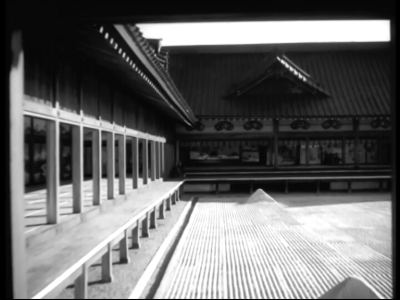
The 47 Ronin, empty courtyard
While Mizoguchi’s use of theatrical music to extend performance space into the real world has already been mentioned, he has also used music in the manner it is conventionally used in stage productions. The most striking example of this is in Ugetsu, when, following the rape of Ohama (Mitsuko Mito), as McDonald writes, “the noh chorus vocalizes her sorrow and indignation.” [15] This shade of difference in style between the postwar film and the earlier ones can also be seen in performance techniques. The previously discussed practice of holding a perfect pose for several moments to express emotion can be seen in all these films. For instance, in Osaka Elegy, Susumu (Kensaku Hara) listens to Ayako’s confession in perfect stillness, with his back to the camera, until he is dragged into her room and falls to his knees to strike a new pose.
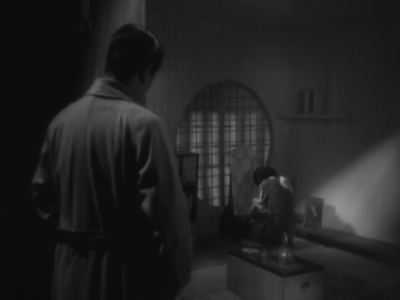
Another example can be seen in The 47 Ronin, when Omino pleads with Oishi to see her lover before he commits hara kiri (ritual suicide). Omino (Mieko Takamine) is on her knees begging, Oishi (Chojuro Kawarasaki) stands in the background, resisting her plea. Behind him, even further back, a retainer stands listening. All three hold stylized poses for several frozen moments. McDonald describes this as “the characteristic Mizoguchi style of letting body language do the work of close-ups.” [16] This emblematic acting is, of course, natural to the theatre, where emotional states have to be as clear to audience members at the back of the theatre as they are in the front row. Yet compare this to Ohama’s leaving the temple following the rape in Ugetsu. A low angle shot frames her against the horizon with her back to the camera. She holds the pose as the noh chorus wails, but there is then a cut as the camera is suddenly closer. This interruption of the long take before the expressive moment ends is not something that is found in the earlier films, and suggests there has been a modification over time of the theatrical influence on his style.
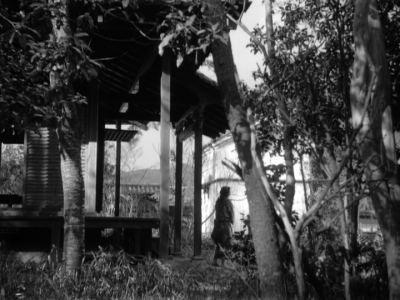
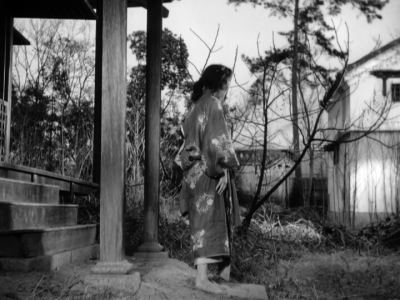
This modification might also be seen in Mizoguchi’s use of the camera. McDonald writes that the reliance on long shots through wide angle lenses in The Story of the Last Chrysanthemum was a result of the casting of Shotaro Hanayagi in the lead even though he was 20 years older than the character he was playing. [17] This had not been a problem when he played the role on the stage, but close-ups had largely ended this theatrical convention in cinema. So the placement of the camera closer to the actors in much of Ugetsu may simply be a function of not having this specific technical problem. However, it is likely that the use of long shots which often replicate the perspectives of theatre audiences is also deliberately intended to reinforce the overt theatricality of Chrysanthemum and The 47 Ronin. This audience perspective is accentuated by unusual camera angles. These angles are of course used in the performance sequences, but more interesting are their use for non-stage action. In the long, single take tracking sequence that features the initial conversation between Otoku and Kikunosuke in The Story of the Last Chrysanthemum, the camera is set well below street level, providing a low angle shot that duplicates the view from the front row of the stalls. Even the curb of the street, visible at the bottom of the frame, seems to deliberately recall the edge of a stage. As in other scenes where theatrical performance spreads into the real world, the sequence is punctuated by occasional sounds of a noh-like voice in the distance and, later, wood block music.
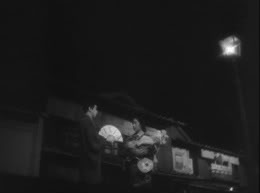
Proscenium stage camera set-up from Chrysanthemum
Another example is in The 47 Ronin, when Lord Asano enters the courtyard and walks to the far end to prepare for his death. Seen from a high angle long shot, it could almost be the view from the cheap seats in the last row of the balcony, even though this effect is mitigated by the camera craning down to floor level for a medium long shot before craning back up to the balcony view.
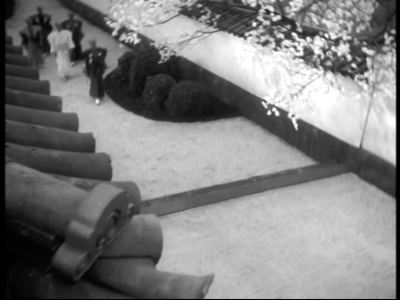
The 47 Ronin
With Mizoguchi, the influence of the theatre is not reflected only in distance and angle. It is also used to highlight the theatrical performance technique. In the scene in The 47 Ronin where Lady Asano receives the news of her husband’s death, McDonald compares the sudden halt of the camera’s movement to a variation of the holding the pose technique, the merihari device, where “a sudden halting of the actor’s gesture leads to a decisive action,” [18] in this case the cutting of her hair as a row of maids in the background, reminiscent of a noh chorus, weep into their sleeves emblematically. Within the long take, the mobile camera can also be seen to serve part of the function that lighting and staging serve in theatrical productions, directing the audience’s eye to specific actions.
Staging, the placing of figures within the frame, is another aspect of Mizoguchi’s style that shows theatrical influence. David Bordwell notes Mizoguchi’s “insistence upon architectural space and . . . how depth and camera movement function to subordinate the human figure to a total composition.” [19] What this technique, which Dudley and Paul Andrew describe as creating a “set of tableaux” [20], can do is accentuate the theatricality of a scene through the construction of a rectangular area within the frame that reproduces a stage-like space in a non-theatrical setting. An example of this is the scene in The 47 Ronin where Oishi discovers the dying former samurai outside Ako Castle. Shadows black out the bottom third of the scene while the top of the building behind defines a horizon lower than the top of the screen. As Oishi kneels at “center stage” and cradles his friend in his arms, he is spotlit by the circular ray of moonlight. The contrast with the stark tree behind them emphasizes his “central” presence, almost directing the viewer’s eye to the light at the base of the dark, blank tree. This creation of stage space is most obvious in The Story of the Last Chrysanthemum where a performance sequence including several wide angle shots of the entire stage is followed by the previously discussed scene of Otoku outside the theater, where shadows at the bottom of the frame and the top of a rectangular building are used to create a theatrical space very similar to that inside the auditorium.
While there are many geometrically rectangular compositions in Ugetsu, none seem to be as consciously theatrical as the earlier films. The staging in Ugetsu does, however, at times reflect a use of theatrical conventions. When Tobei (Eitaro Ozawa) returns after his first trip to town, he lurks outside Genjuro’s hut. Ohama runs out and, instead, of yelling at him there, she drags him back into the hut (“onstage,” where the audience can see the action) before yelling at him. The camera does not follow Ohama, choosing instead to remain in its seat. Ugetsu also uses the stage convention of having characters react to the noise of offstage battles or action that would be impossible to reproduce on stage. Cinema can reproduce these actions, but Mizoguchi prefers to keep the signs of war to handfuls of soldiers and the sound of offscreen gunfire. Even this can be seen as a modification of how this convention was used in The 47 Ronin where, as Leach writes, “the key strategy . . . is the almost total omission of the kind of spectacular action that would be expected in a film on this subject.” [21]
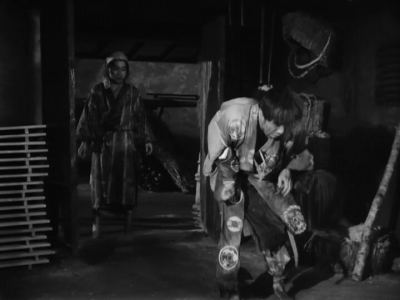
Ugetsu
Although Ugetsu may be more conventionally “cinematic” and less obviously theatrical than the earlier films, the ending features two memorable adaptations of stage devices. When Genjuro arrives at his empty hut, walks around it and reenters to find Miyagi (Kinuyo Tanaka), this is strikingly evocative of the mawari-butai in kabuki staging. What is involved is the use of a stage on wheels that revolves to present a new set while the performers enact a transitional scene. So when Genjuro completes his circle, it is as if a new hut has slid in to replace the old one. The other theatrical device is used after Genjuro falls asleep and the ghost of Miyagi waits for daybreak. In terms of screen time, it is roughly a minute, but the changes in the light penetrating the house from outside suggest that several hours have passed in story time. In cinema this is usually accomplished through dissolves or other types of editing within the scene, but the discipline of the long take requires the use of this theatrical device, common in a medium that, as mentioned, routinely tells its stories in a series of long takes.
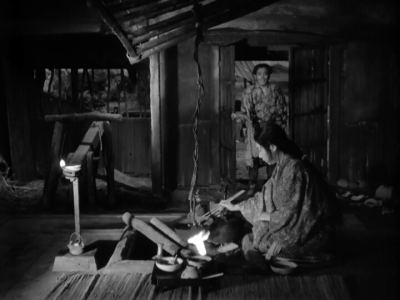
Ugetsu
Dudley and Paul Andrew argue that “no other major Japanese filmmaker . . . has tried to incorporate so many elements of the theatre into his films.” [22] It served as a source of both visual and narrative techniques, influencing to some extent almost every aspect of his directorial style. At the same time, these theatrical elements never seem static or stagey, but achieve a synthesis between the media of film and theatre that is distinctively cinematic.

Lady Wakasa’s ‘noh-like’ makeup/costume and movements from Ugetsu
Endnotes
1 Keiko McDonald, Mizoguchi (Boston, MA: Twayne Publishers, 1984), 17
2 Dudley Andrew, “The Passion of Identification in the Late Films of Kenji Mizoguchi,” Film in the Aura of Art (Princeton, NJ: Princeton University, 1984), 181
3 Tadao Sato, “On Kenji Mizoguchi,” Film Criticism 4, no. 3 (Spring 1980): 7
4 Peter Morris, “The Cinema of Mizoguchi,” in Kenji Mizoguchi, ed. Peter Morris (Ottawa, ON: Canadian Film Institute, 1967), 1
5 Morris, “The Cinema of Mizoguchi,” 5
6 Kenji Mizoguchi, “Mizoguchi: Three Statements,” in Kenji Mizoguchi, ed. Peter Morris (Ottawa, ON: Canadian Film Institute, 1967), 10
7 Morris, “The Cinema of Mizoguchi,” 5
8 Keiko McDonald, “Form and Function in Osaka Elegy,” Film Criticism 6, no. 2 (Winter 1982): 39-40
9 Noel Burch, “Kenji Mizoguchi,” To the Distant Observer (Berkeley and Los Angeles, CA: University of California Press, 1979), 230
10 Tadao Sato, “On Kenji Mizoguchi,” 7
11 Dudley Andrew and Paul Andrew, Kenji Mizoguchi: A Guide to References and Resources (Boston, MA: G.K. Hall & Co., 1981), 38
12 Keiko McDonald, “Ugetsu: Why Is It a Masterpiece?” Ugetsu (New Brunswick, NJ: Rutgers University Press, 1993), 12
13 Noel Burch, “Kenji Mizoguchi,” 238
14 James Leach, “Mizoguchi and Ideology: Two Films from the Forties,” Film Criticism 8, no. 1 (Fall 1983): 70
15 Keiko McDonald, “Ugetsu,” 11
16 McDonald, Mizoguchi, 67
17 McDonald, Mizoguchi, 56
18 McDonald, Mizoguchi, 66
19 David Bordwell, “Mizoguchi and the Evolution of Film Language,” in Cinema and Language, eds. Stephen Heath and Patricia Mellencamp (University Publications of America, AFI, 1983), 112
20 Andrew and Andrew, Kenji Mizoguchi: A Guide to References and Resources, 37
21 Leach, “Mizoguchi and Ideology,” 67
22 Andrew and Andrew, Kenji Mizoguchi: A Guide to References and Resources, 31
Bibliography
Andrew, Dudley. 1984. The passion of identification in the late films of Kenji Mizoguchi. In Film in the Aura of Art. 172-192. Princeton, NJ: Princeton University.
Andrew, Dudley and Andrew, Paul. 1981. Kenji Mizoguchi: A Guide to References and Resources. Boston, MA: G.K. Hall & Co.
Bordwell, David. 1983. Mizoguchi and the evolution of film language. In Cinema and Language., eds. Stephen Heath, Patricia Mellencamp, 107-117. University Publications of America, AFI.
Burch, Noel. 1979. Kenji Mizoguchi. In To the Distant Observer, 217-246. Berkeley and Los Angeles, CA: University of California Press.
Leach, James. Mizoguchi and Ideology: Two films from the Forties. Film Criticism 8, (1) (Fall 1983): 66-78.
McDonald, Keiko. 1993. Ugetsu: Why is it a masterpiece? In Ugetsu, 3-16. New Brunswick, NJ: Rutgers University Press.
———. 1984. Mizoguchi. Boston, MA: Twayne Publishers.
———. Form and function in Osaka Elegy. Film Criticism 6, (2) (Winter 1982): 35-44.
Mizoguchi, Kenji. 1967. Mizoguchi: Three statements. In Kenji Mizoguchi, ed. Peter Morris, 9-13. Ottawa, ON: Canadian film Institute.
Morris, Peter. 1967. The Cinema of Mizoguchi. In Kenji Mizoguchi, ed. Peter Morris, 1-6. Ottawa, ON: Canadian Film Institute.
Sato, Tadao. On Kenji Mizoguchi. Film Criticism 4, (3) (Spring 1980): 2-16.

